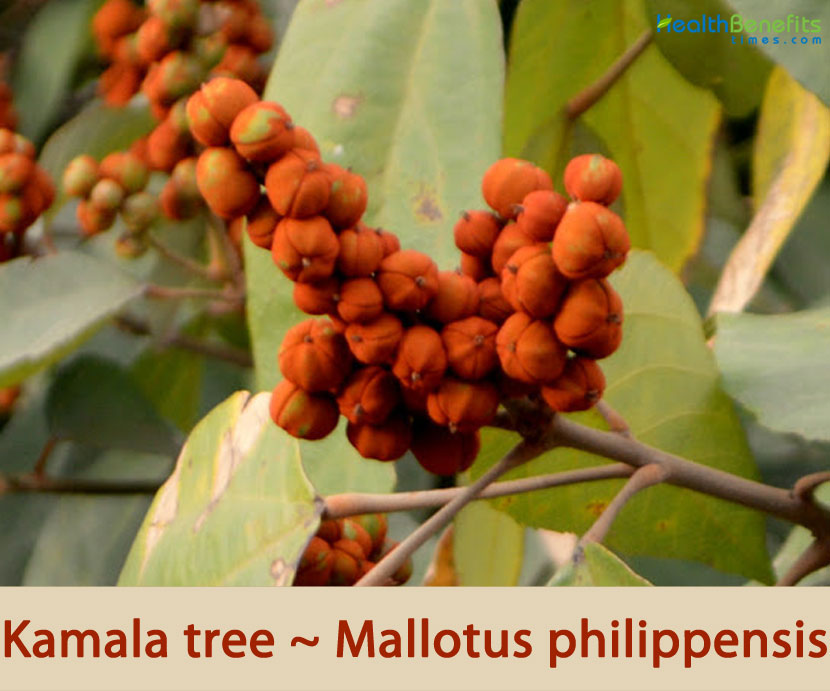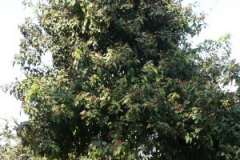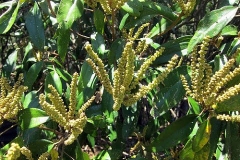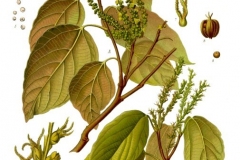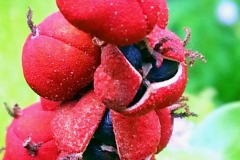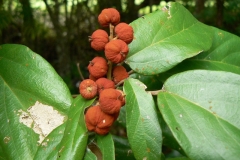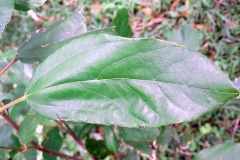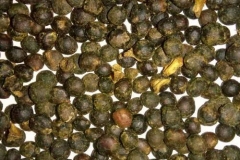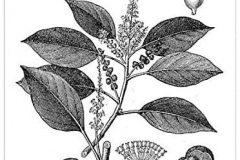| Kamala tree Quick Facts | |
|---|---|
| Name: | Kamala tree |
| Scientific Name: | Mallotus philippensis |
| Origin | South Asia, South East Asia and might originate from the Philippines |
| Colors | Red |
| Shapes | Depressed-globose, 3-lobed capsule, 5-7 mm long and 8-10(-12) mm wide |
| Taste | Bitter, pungent |
| Health benefits | Beneficial for constipation, flatulence, ulcers, cough, internal bleeding, renal and vesicle stones, bronchitis, abdominal diseases and spleen enlargement |
| Name | Kamala tree |
|---|---|
| Scientific Name | Mallotus philippensis |
| Native | South Asia, South East Asia and might originate from the Philippines. It has a wide range, from Mount Keira (N.S.W) in the extreme south and all the way to Afghanistan at the northern limit |
| Common Names | Kamala tree, Monkey Face Tree, Dyers rottlera, Kamala dye tree, Orange kamala, red kamala, scarlet croton, Kamala, rohini, senduri ,gangai, shendri, monkey-puzzle , rechanka, raktaang, kapila, sindooramaram, kuramedakku, kunrang umanjal, korangumanjanati |
| Name in Other Languages | Arabic: Qanbîl (قنبيل), ورس Wars, Kinbil Assamese: Rohini phal, Lochan, Joroth, Gangai, puddum Bodo: Sindhur biphang Bengali: Kamala (কমলা), Kamalagundi Burmese: Hpawng-awn Cambodia: An-nadaa Chinese: Cu kang chai (粗糠柴), Jia ma la, Xiang gui shu (香桂樹), Liù niǎn zǐ (六捻仔), Láo lī zǐ (嘮哩仔), Shì hú mù (柿糊木), Fēi dǎo tóng (菲島桐), cukangcai, feilibingtong, hong guoguo, xiang guishu, xiang qiuteng, Xiangtan Cambodia: Annadaa Czech: Rotlera filipinská Danish: Kamala Dutch: Kamala English: Kamala, Kamala-tree, Monkey-faced tree, Orange kamala, Red kamala, monkey face tree, Kumkum Tree, Red Berry, Kamala Dye Tree Estonian: Punamarjane kamalapuu French: Croton tinctorial, Rottlière des teinturiers German: Kamalabaum Gujarati: Kapilo Hindi: Kaamalaa (कामला), Kamaalaa (कमाला), Raini (रैनी), Rohan (रोहन), Rohini (रोहिनी), Roolii (रोली), Kamala (कामला), Sinduri (सिन्धुरी), Raini, kambhal, kamal, kemela, kambal, kambila, kamela, kamila, kamla, kamud, rauni, rohni, roini, roli, rora, ruena, ruin, ruina, rulu, senduria, sindur Indonesia: Galuga furu, kapasan, kimeyong Irula: Chenoori Italian: Kamala Japanese: Kusunohagashiwa (クスノハガシワ) Kannada: Kampillaka, Kunkuma damara (ಕುಮ್ಕುಮದ ಮರ), Kumkuma damara, Maloṭas philipennasis (ಮಲೊಟಸ್ ಫಿಲಿಪೆನ್ನಸಿಸ್), Kunkumada, candrahittu, chandra hittu, chandrahittu, corungamanje, dholo, etthunaalige, ettunalige, honne, hulicellu, hulichellu, hulichendu, hullichellu, kaesari maavu, kapeelaa rangu, kapila, kapile, kaseri, kesari, kesarimavoo, kesarimavu, korangumunji, kumkumada mara, kunkuma, kunkume, kurku, munnaga, ponne, ponneda, punnaga, purushatunga, saruakasari, surahonne, suraparni, suvarnakesari, vasare Khmer: Annadaa Laotian: Kh’aay paax, Khiiz moon, Tangx thôôm Malay: Balik angin, Galuga furu, Kapasan, Kasirau, Ki meyong, Rambai Kuching Malaysia: Balik angina, kasirau, rambai kuching, minyak madja Malayalam: Ceṅkēāli (ചെങ്കോലി), Cindooram (സിന്ദൂരം), Kampipala (കമ്പിപാല), Kapila (കപില), Kapilam (കപിലം), Kunkumam (കുങ്കുമം), Kunkumappuumaram (കുങ്കുമപ്പൂമരം), Kuramadakka (കുരമടക്ക), Kuramadakku (കുരമടക്കു), Kurangumanjas (കുരങ്ങുമഞ്ഞശ്), Kuruku (കുറുക്), Kurukkutti, Manjana, Taavatta (താവട്ട), Nuurimaram (നൂറിമരം), Pipponnakam, Ponni, Pinoo, Ponnagam, Ponnakam, Ponoo, Punna, Shenkolli, Sinduri, Tavitu, Thavatta, Noorimaram, Manjanampottu, Kurangumanjal, Kunkumam, ceṅkeālli (ചെങ്കൊല്ലി), Kampipala, Sindooram Malaysia: Balik angina, kasirau, rambai Kuching Manipuri: Ureirom laba Marathi: Kapila (कपिला), Kesari (केशरी), Shendri (शेंदरी), rohinee (रोहिणी), Shindur Mizo: Thingkhei Myanmar: Hpawng-awn Nepali: Sindhu re (सिन्धुरे) Oriya: Bosonto-gundi, Kumala, Sundragundi, Kamalagundi Papua New Guinea: Tore Persian: Kanbela Philippines: Banato, pangaplasin, tagusala Punjabi: Kumila, Kamal, Kambal, Kamela Russian: Mallot filippinskii (Маллот филиппинский), Mallot kamala (Маллот камала), Mallotus kamala (Маллотус камала), Malotus filippinskii (Маллотус филиппинский) Sanskrit: Kampilyakah (काम्पिल्यक) Kampilyaka, bahupushpa, chandra, kamala, kambha, kampiliaka, kampilla, kampillah, kampillaka, kampillakah, , kapila, karkasha, kesara, laghupatraka, lohitanga, madhuka, nadivasa, pikaksha, punnaga, punnagakesara, punnama, rajanaka, rajanikah, raktanga, raktaphala, ranjaka, recanakah, rechanaka, rechani, rechi, rochana, varnaka Siddha: Kamela Spanish: Kamal Swedish: Kamala Tagalog: Apuyot, Banato, Tagusala Tamil: Kamala, Kanapotta, Kapila, Kapilapodi, Kapila poti (கபிலப்பொடி), Kapili, Kapli, Konaspootoo, Kungumam, Kunnancholai, Kuranku-mancanari (குரங்குமஞ்சணாறி), Kurangu manjanathi, Manjanai, Thavattai, Thirisalakkaai, Vassuntagunda, sundari, Vasanta, kum, avam, cinturamaram, cuvannakecari, cuvarnakecari, kabilam, kabilappodi, kamalai, kamalappoti, kambosam, kamela, kamela-mavu, kamelamavumaram, kamlappoti, kampocam, kampocam, kapilam, kapilappoti, kapilappotimaram, kecavam, kopilapodi, kumpikam, kunkumam, kunkumamaram, kurangumanianatti, kuranku mancanari, kurankumunci, kurankumuncimaram, mancanai, manjanai, maravam, nakamucikai, nakarattam, naravam, naravam, naravu, punnakam, tanittai, tavattai, thavattai, tiruccalai Telugu: Kunkumachettu (కుంకుమ చెట్టు), adavigabathodu, adavigubatada, adavigubbathadu, adavigubbathuda, adavigubbatuda, adivigubatadu, benduruppu, cendiramu, chendiramu, chendra, chendurapu, kapila-podi, kapilapodi, kukuma, kukumapuvvu, kumkumamu, kunkuma, , naagaraktha, nagarakta, nagaruttu, pachi, punnagam, sendhoori, sindhooragunda, sinduragunda, sinduri, sindurni, sundaragundi, sundari, sundharashundi, thunga, thungavriksham, tunga, vasant, vasanta, vasantagandhamu, vasantagundamu, vasantangauda, vasanthagandhamu, vasanthagunda, vasanthagundi, vasanthgunda chettu, vassanta, vassuntagunda, vassuntagundu, veligarapu, vusuntagundha, wusuntagundha Thai: Cha tri khao (ชาตรี ขาว), Kai khat hin (กาย ขัดหิน), Kham daeng (คำแดง), Kham saet (คำแสด), Khi nuea (ขี้ เนื้อ), Lai tua phu (ลายตัวผู้), Ma khai (มะคาย), Makai khat (มะกายคัด), Sa-bo-se (ซาบอเส่), Thaeng thuai (แทงทวย) Tibetan: Ka bi la ya ka, kam pi lya ga Unani: Kamila Urdu: Kamala, kamela, kamila, qimbeel, roghan kamila Vietnamese: Ba chia, Canh kiên, Rùm nao |
| Plant Growth Habit | Small bush or even a pretty sized monoecious tree |
| Growing Climates | Common in evergreen forest, especially in secondary forest. It also occurs in scrubby vegetation and on open rocky ground, mountain slopes or valleys, limestone hills or river valleys and shola borders in forest clearings |
| Soil | Grow mostly in a wide range of soil types, including infertile soils, limestone, acid, and rocky land |
| Plant Size | Up to 25 m tall with a bole up to 50 cm in diameter |
| Trunk | Trunk is fluted and irregular at the base |
| Bark | Grey bark is smooth, or with occasional wrinkles or corky bumps |
| Branches | Small branches are greyish brown in color, with rusty covered small hairs towards the end |
| Leaf | Opposite on the stem in opposite pairs and can have a length between 4 to 12 cm, with a thickness of about 2 – 7 cm. Their shape can be either ovate or oblong, with sharp tips |
| Flowering season |
|
| Flower |
|
| Fruit Shape & Size | Depressed-globose, 3-lobed capsule, 5-7 mm long and 8-10(-12) mm wide, with abundant orange or reddish glandular granules, 3-seeded |
| Fruit Color | Red |
| Seed | Seeds are subglobose and black in color and 4 mm across |
| Propagation | By seeds |
| Taste | Bitter, pungent |
| Plant Parts Used | Lleaves, seed, stem bark, flowers, roots |
| Season | July-August |
However, it must be noted however that kamala also means lotus in many languages of India. Kamala is unrelated to lotus, which is a completely different plant with an attractive flower and an important symbolic value in Asia. The species name refers to the type specimen being collected in the Philippines, where it is known as banato. Kamala is considered to be a very useful tree. It is source of Kamala dye which is used in coloring silk and wool. It is used as anti-oxidant for ghee and vegetable oils. Oil is used as hair-fixer and added in ointment. Seed oil is used in paints and varnishes. Seed cake is used as manure.
It is considered the best source of kamala powder, widely used in Asia as a dye and medicine, the plant also provides a useful timber, oil and tannins. The tree has been grown experimentally in Nepal because of the endangered stands of this tree, and was previously cultivated in Cameroon and Madagascar. It is grown as an ornamental, being appreciated particularly for its red fruits.
Plant Description
Kamala tree is a small bush or even a pretty sized monoecious tree that normally grows up to 25 m tall with a bole up to 50 cm in diameter. The plant is commonly found growing in evergreen forest, especially in secondary forest. It also occurs in scrubby vegetation and on open rocky ground, mountain slopes or valleys, limestone hills or river valleys and shola borders in forest clearings. It grows mostly in a wide range of soil types, including infertile soils, limestone, acid, and rocky land. The trunk is fluted and irregular at the base. The grey bark is smooth, or with occasional wrinkles or corky bumps. Small branches are greyish brown in color, with rusty covered small hairs towards the end. Leaf scars are evident.
Leaves
Leaves grow opposite on the stem in opposite pairs and can have a length between 4 to 12 cm, with a thickness of about 2 – 7 cm. Their shape can be either ovate or oblong, with sharp tips. The upper surface is green and smooth without hairs, while the bottom is faint grey and has some very small red glands that can only be noticed with a magnifier or microscope. The stems of the leaves can grow to a maximum length of 5 cm, somewhat thickened at both ends. Veins are raised and very visible on the underside of leaves and the first one is the most important, being as long as half of the leaf.
Flowers
Kamala’s flowers are situated on racemes with a length of up to 6 cm and have a yellow or brownish color. Every tree has a different sex and the male and female flowers can’t be found on the same one. Male flowers in terminal and axillary position, 2–10 cm long, solitary or fascicled paniculates spikes, each flower are with numerous stamens, small. Female flowers have spikes or slender racemes, each flower with a stellate hairy, 3 celled ovary with 3 papillose stigmas. Given the vast range where the plant is found, the blossom happens at different times of the year. Flowers appear in March to April in the Philippines but as late as June to November in Australia’s New South Wales province.
Fruits
About three months after the blossom, the fruits start to mature, in any month of the year. Fertile flowers are followed by depressed-globose capsules with three lobs. Capsule is 5-7 mm long and 8-10(-12) mm wide. Their most interesting feature is the red powder that covers them. Diluting this powder in alcohol produces a red dye that can be used to color wool and silk. Every lobe consists of a small black subglobose seed, not larger than 2 – 3 mm in diameter, which can be used when it’s fresh to propagate the tree.
Health benefits of Kamala Tree
Here are few of the popular health benefits of Kamala tree
1. Infection Disease Treatment
Kamala leaves have powerful antimicrobial property effective against Streptococcus pneumoniae and thus prevent and treat this organism causing infections like pneumonia, septic, brain abscesses, etc. Kamala leaves extract is also suggested to treat typhoid fever, as it is effective against Salmonella typhi. It also destroys Vibrio species and treats diarrheal infections. Kamala leaves also has anti-filarial action. Not only leaves, but the stem of Kamala also has an inhibitory effect against fungi A. flavus and C. albicans.
2. Anticancer
Kamala root is effective against leukemia due to its anti-proliferative activity. The anti-leukemic effect of Kamala is tested and the test result showed that Kamala can up-regulate protooncogenes within 24 hours of treatment and allow to limit leukemic cell cycle progression.
3. Anti-Tumor Activity
Stem bark of Kamala root prevents the effect of antigen derived from Epstein-Barr virus. The antitumor property of Kamala is more powerful than another well-established herbal constituent like curcumin. An animal research study confirmed the anti-tumor activity of Kamala.
Traditional uses and benefits of Kamala Tree
- Kamala tree is used by the Arabs internally for leprosy and in solution to remove freckles and pustules.
- Kamala herb is effective in digestive problems like constipation, flatulence or tapeworms but also heals ulcers, cough, internal bleeding, renal and vesicle stones.
- It can also eliminate scabies and other types of skin parasites.
- Kamala is considered among the best herbal remedies for internal worms.
- It can kill many types of parasites, both internal and external ones, especially those that live on the skin or along the digestive tract.
- Fruit and its hair are particularly effective against parasites, while the bark is a powerful germ killer.
- It eliminates toxins; it can boost bowel activity, improve digestion and act like a laxative.
- Local traditional practitioners also use the plant in the treatment of eye disorders.
- Kamala powder, obtained from the skins of the fruits, is used as anthelmintic.
- All parts of the tree can be applied externally to treat parasitic infections of the skin.
- Fruits and bark have been used medicinally to treat stomach ulcers and tapeworm.
- Decoction of the leaves is used in the treatment of diarrhea.
- Root scrapings are chewed with a betel mixture as a contraceptive for women.
- It is useful in treatment of bronchitis, abdominal diseases, and spleen enlargement.
- Powder and a few other parts of Kamala are also used in external applications to promote the healing of ulcers and wounds.
- They are used to treat parasitic affections of the skin like scabies, ringworm, and herpes.
- Bark has been used for typhoid and meningitis.
- Its oil is used in dermal problems and non-healing wounds.
- Leaves are used externally for different types of skin infections and infected wounds.
- The glands/hairs of the fruit mixed with coconut oil are used to dress wounds and burns.
- The oil cleanses chronic infected wounds.
- Oil extracted from the Kamala seeds is applied to non-healing dermal wounds.
- Chewing of a combination of small sectioned Kamala root with betel mixture is acts as a contraceptive for women.
- Leaves and flower extract of Kamala plant has anesthetic properties and is used as a traditional medicinal substance to treat flu, cough, stomatitis, rabies diseases, tuberculosis, and throat complaints.
- It is an effective remedy to treat fever and rheumatism. It has strong diuretic activity and can dissolve urinary calculi.
- In India, it is used for bronchitis, abdominal diseases, spleen enlargement.
- Leaves and bark are used for poulticing cutaneous diseases and pounded seeds are applied to wounds.
- It is used for constipation, anorexia, cancers, dermatosis, cramps and dysmenorrhea.
- Dried seed powder mixed with half cup of curd is given three times daily for 1 to 2 days for constipation and to kill intestinal worms in Pakistan.
- In Manipur India, bark decoction with sugar given in urinary tract stone problem.
Ayurvedic Health benefits of Kamala Tree
- Wounds: Crush Mallotus Philippensis seeds to make powder. Sprinkle it over Wounds.
- Cracked Heels : Take 50 gram Adina Cordifolia Oil, 50 gram Kamala Oil, 50 gram Bergenia Oil, 50 gram Indian Madder Oil, 50 gram Dandelion Oil, 50 gram Vateria Indica Oil, 100 gram Aloe Vera Gel and 50 gram of Dried Powdered of kokum. Put all oils in a pan. Heat the combination on a low flame. After 15 to 20 minutes, add the remaining ingredients. Stir it time to time. When the mixture becomes thick, remove from the heat. Let it cool. Store in a bottle. Use it on cracked heels at night daily.
Culinary Uses
- Kamala powder, obtained from the skins of the fruits, is used as a preservative for vegetable oils and dairy products.
- The oil from the seed is used for coloring foodstuffs and beverages.
- Dye made up of Kamala herbal content is used to brighten ice-cream and drinks.
Other Facts
- The red dye produced from the fruit is used to color silk and wool.
- Paper can be produced from the wood pulp, while the seeds serve as manure.
- The red pigment can also be used for cooking.
- Wood is good as fuel; leaves can be eaten by domestic animals, while the Chinese use the plant to grow lac insects.
- Tree’s bark is fibrous, which is useful in the manufacture of ropes, artificial fur, baskets and even synthetic furs.
- In Sumatra the plant is used as a fish poison.
- Oil is also used as a fixative in cosmetic preparations and for coloring foodstuffs and beverages.
- Wood is used for rafters, tool handles, matchboxes, and house-posts.
- The wood is often used as fuel wood.
- It is considered well as anti-oxidant for ghee and vegetable oils.
- Seed Oil derived from the seeds is used in paints and varnishes, as hair-fixer, and ointment additive.
- Seed cake is used as manure.
Precautions
- Avoid use during pregnancy and breast feeding.
- Do not consume if you have symptoms of appendicitis.
- Large doses may cause colic, cramping, diarrhea, GI distress, and nausea.
- It may cause mild nausea, occasional vomiting and loose motions.
References:
https://www.itis.gov/servlet/SingleRpt/SingleRpt?search_topic=TSN&search_value=503670#null
https://npgsweb.ars-grin.gov/gringlobal/taxon/taxonomydetail?id=23192
https://botanical.com/botanical/mgmh/k/kamala01.html
https://gd.eppo.int/taxon/MLLPH
http://www.theplantlist.org/tpl/record/kew-119039
https://indiabiodiversity.org/species/show/31523
https://uses.plantnet-project.org/en/Mallotus_philippensis_(PROSEA)
https://plants.usda.gov/core/profile?symbol=maph4
http://tropical.theferns.info/viewtropical.php?id=Mallotus+philippensis
https://www.hindawi.com/journals/bmri/2014/213973/
http://www.efloras.org/florataxon.aspx?flora_id=2&taxon_id=242413649
https://www.researchgate.net/publication/318257394_MALLOTUS_PHILIPPENSIS_A_MIRACLE_STICK
https://www.flowersofindia.net/catalog/slides/Kaamla%20Tree.html
https://hort.purdue.edu/newcrop/CropFactSheets/kamala.html


